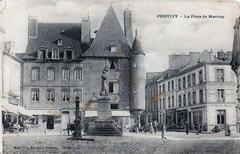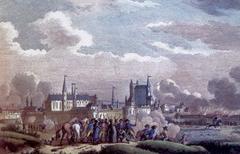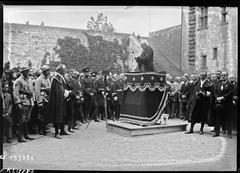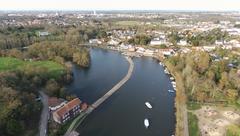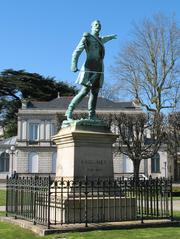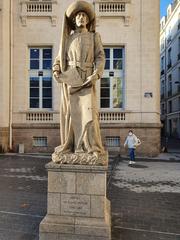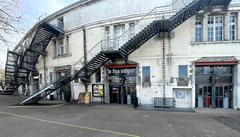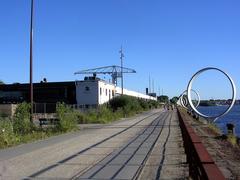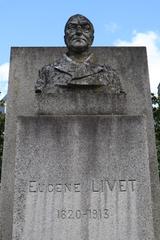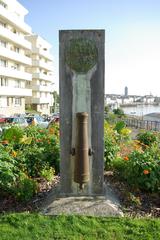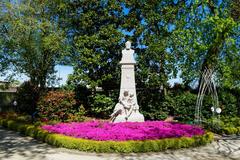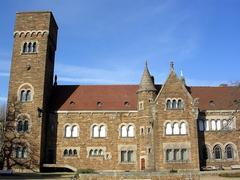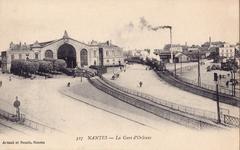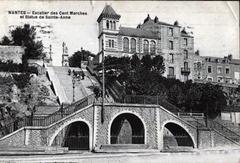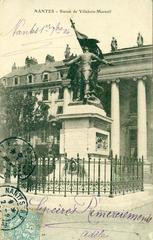Fontaine Royale Nantes: Visiting Hours, Tickets, and Travel Guide
Date: 14/06/2025
Introduction
Nestled at the heart of Nantes, France, the Fontaine Royale is more than just a striking neoclassical fountain—it is a living testament to the city’s dynamic history, artistic evolution, and enduring maritime spirit. Located in the elegant Place Royale, this monumental 19th-century landmark has witnessed the city’s transformation from medieval stronghold to modern urban hub. With its intricate sculptures, symbolic features, and vibrant surroundings, Fontaine Royale stands as both a civic icon and a central gathering place, offering visitors a memorable immersion into Nantes’ unique cultural identity (Wikipedia, FYKmag, Cityzeum).
This detailed guide covers everything you need to plan your visit: from historical context and architectural highlights to practical information on access, guided tours, events, and nearby attractions. Whether you’re a seasoned history buff, art enthusiast, or a curious traveler, Fontaine Royale offers a vibrant glimpse into the very soul of Nantes.
Table of Contents
- Historical Background
- Architecture and Artistic Detailing
- Civic and Cultural Significance
- Integration with Nantes’ Artistic Heritage
- Current State and Restoration
- Visiting Information
- Nearby Attractions and Suggested Itineraries
- Events and Cultural Atmosphere
- FAQs
- Conclusion and Final Tips
- References
Historical Background
Origins and Urban Transformation
The story of Fontaine Royale begins with the ambitious redevelopment of Nantes in the late 18th century. In 1786, Mathurin Crucy designed Place Royale as part of an urban renewal following the demolition of the city’s medieval ramparts. Realized in 1790, the square became a showcase of neoclassical harmony, with nine streets radiating outward and uniform facades that echoed royal squares found throughout France (Wikipedia, FYKmag).
Creation of the Fountain
While the vision for a grand public fountain in Nantes dates back to the 16th century, it was not until the mid-19th century that the city commissioned Henri-Théodore Driollet to design the Fontaine Royale. Inaugurated in 1865, the fountain quickly became the square’s centerpiece, symbolizing both urban progress and civic pride (FYKmag).
Artistic Symbolism
The fountain’s white marble summit features Nantes personified as a crowned woman holding a trident—a nod to the city’s maritime legacy. Surrounding her, sculpted figures represent the Loire River and its tributaries (Erdre, Sèvre, Cher, and Loiret), alongside allegorical genii of industry and commerce. These elements collectively celebrate Nantes’ connection to its waterways and its historical role as a commercial powerhouse (Wikipedia, Cityzeum).
Place Royale Through the Ages
From its 19th-century emergence as a commercial and civic hub to its resilience through wartime damage and postwar restoration, Place Royale reflects the evolving identity of Nantes. The square was central to political protests, festive gatherings, and urban renewal, including pedestrianization and the hosting of major cultural festivals (Wikipedia, Le Voyage à Nantes).
Architecture and Artistic Detailing
The Fontaine Royale and its surroundings are masterpieces of neoclassical urban design. The square’s symmetrical layout, arched ground floors, and stately balconies create an inviting yet grand civic space (Cityzeum). The fountain itself is a study in allegorical sculpture—its expressive figures, flowing drapery, and dynamic arrangement highlight the high standards of 19th-century French public art.
Civic and Cultural Significance
Fontaine Royale has always served as both a visual and social focal point for Nantes. Symbolizing the city’s “blue and green” identity—defined by water and lush public spaces—the fountain is a favored meeting spot, central to the rhythms of local life. The area’s cafes, shops, and cultural venues reinforce the square’s role as a living canvas for daily activity and special events (Megan Starr).
Integration with Nantes’ Artistic Heritage
As a key waypoint on the “Voyage à Nantes” cultural trail, Fontaine Royale is interwoven with the city’s contemporary creative scene. The square links seamlessly to nearby attractions like Passage Pommeraye and the Musée d’Arts de Nantes, making it a natural starting point for exploring Nantes’ rich artistic landscape (Le Voyage à Nantes, Megan Starr).
Current State and Restoration
In January 2024, the fountain’s central statue of Amphitrite lost one of its arms due to natural wear, prompting an immediate restoration effort by the city (Actu.fr). Protective barriers now surround the fountain, and professional restorers are assessing its condition. While close-up access is temporarily restricted, the fountain remains visible and Place Royale continues to host markets, events, and daily life.
The restoration process, highlighted as part of Nantes’ cultural programming, gives visitors the unique opportunity to witness heritage preservation in action (Actu.fr, Le Voyage à Nantes).
Visiting Information
Hours and Access
- Open 24/7: Place Royale and Fontaine Royale are outdoor public spaces accessible at all times. For the best views and active water features, visit between 9:00 AM and 8:00 PM during daylight hours.
Tickets and Tours
- Free Entry: No ticket is required to visit the fountain or the square.
- Guided Tours: Local operators and the Nantes tourist office offer historical walking tours, often included in the Pass Nantes. Booking in advance is recommended, especially in peak seasons (Loire Lovers).
Accessibility
- Wheelchair Accessible: The square features flat, paved surfaces and is close to accessible public transport and parking.
- Inclusive Services: Nantes provides accessibility guides, French sign language videos, and adapted information for visitors with sensory or cognitive impairments (Le Voyage à Nantes).
Amenities and Facilities
- Cafes, restaurants, and shops line the square and nearby streets.
- Public restrooms, ATMs, and pharmacies are within easy reach.
- Luggage storage is available at nearby hotels.
Practical Travel Tips
- Public Transport: Nantes’ tram and bus network offers convenient access to Place Royale (Loire Lovers).
- Self-service Bicycles: Over 120 stations across the city.
- Driving: Not recommended due to limited parking.
- Weather: May–June is ideal (17–21°C); July–August is warmer but busier (TravelSetu, Weather25).
- Footwear: Comfortable shoes are essential for walking and exploring neighboring districts.
- Safety: The area is generally safe, but be vigilant during crowded events.
Nearby Attractions and Suggested Itineraries
From Fontaine Royale, visitors can easily reach:
- Passage Pommeraye: Ornate 19th-century shopping arcade (Travel France Bucket List)
- Graslin Square and Theatre: The heart of Nantes’ cultural life
- Nantes Cathedral: Gothic architecture and the tomb of the last Duke of Brittany
- Cours Cambronne: Tranquil promenade garden
- Château des Ducs de Bretagne: Museum and castle, fully accessible and included in the city pass (Le Voyage à Nantes)
The “Voyage à Nantes” green line connects these sites on a well-signposted urban trail.
Events and Cultural Atmosphere
Place Royale and its fountain are at the center of Nantes’ cultural calendar, hosting everything from open-air art installations during the “Voyage à Nantes” festival to seasonal markets and public celebrations. The square’s historical significance is reflected in its role during key events like the 1918 Armistice, the 1936 strike, and the May 1968 protests (Navaway). Street performers, musicians, and pop-up markets animate the square, especially in summer (TravelSetu).
Frequently Asked Questions (FAQ)
What are Fontaine Royale’s opening hours?
The square is accessible 24/7, with water features generally active from 9:00 AM to 8:00 PM.
Is there an entrance fee?
No, both the fountain and square are free to access.
Are guided tours available?
Yes, walking tours are available through local operators and often included in the Pass Nantes (Loire Lovers).
Is the area accessible for wheelchair users?
Yes, Place Royale is flat and barrier-free, with additional city resources for visitors with disabilities (Le Voyage à Nantes).
Is photography allowed?
Yes, the square and fountain are popular photography spots.
Is the fountain currently under restoration?
Yes, as of June 2025, restoration is in progress, so close-up access may be restricted (Actu.fr).
Conclusion and Final Tips
Fontaine Royale is more than a decorative landmark—it is a living symbol of Nantes’ maritime and commercial heritage. Its neoclassical architecture, allegorical sculptures, and central location make it a must-see for anyone visiting the city. Despite current restoration work, the site remains open and integral to Nantes’ dynamic urban life. With free access, comprehensive accessibility, and proximity to major attractions, Fontaine Royale is perfectly positioned for travelers seeking to experience the city’s historical depth and vibrant atmosphere.
To enhance your visit, consider using the Pass Nantes for transport and guided tours, checking event calendars for festivals or art installations, and exploring the square’s cafes and shops. For the latest updates on restoration, visiting hours, and events, download the Audiala app or consult official tourism resources.
References
- Place Royale (Nantes), Wikipedia
- Nantes ville où l’art et la culture sont partout accessibles, FYKmag
- Place Royale de Nantes, Cityzeum
- Nantes Things to Do, Megan Starr
- Patrimoine de Nantes: La statue de la fontaine de la Place Royale a perdu un bras, Actu.fr
- Le Voyage à Nantes, Official Site
- Best Things to Do in Nantes, Best Things To Do In City
- Things to Do in Nantes, Voyage Tips
- Visit Nantes 3 Days, Loire Lovers
- Place Royale Tourism: Best Time to Visit, TravelSetu
- Weather in Nantes, June 2024, Weather25
- Visit Nantes: Place Royale, Navaway
- Accessibility for the Disabled in Nantes, Le Voyage à Nantes
- 2 Days in Nantes Itinerary, Travel France Bucket List
